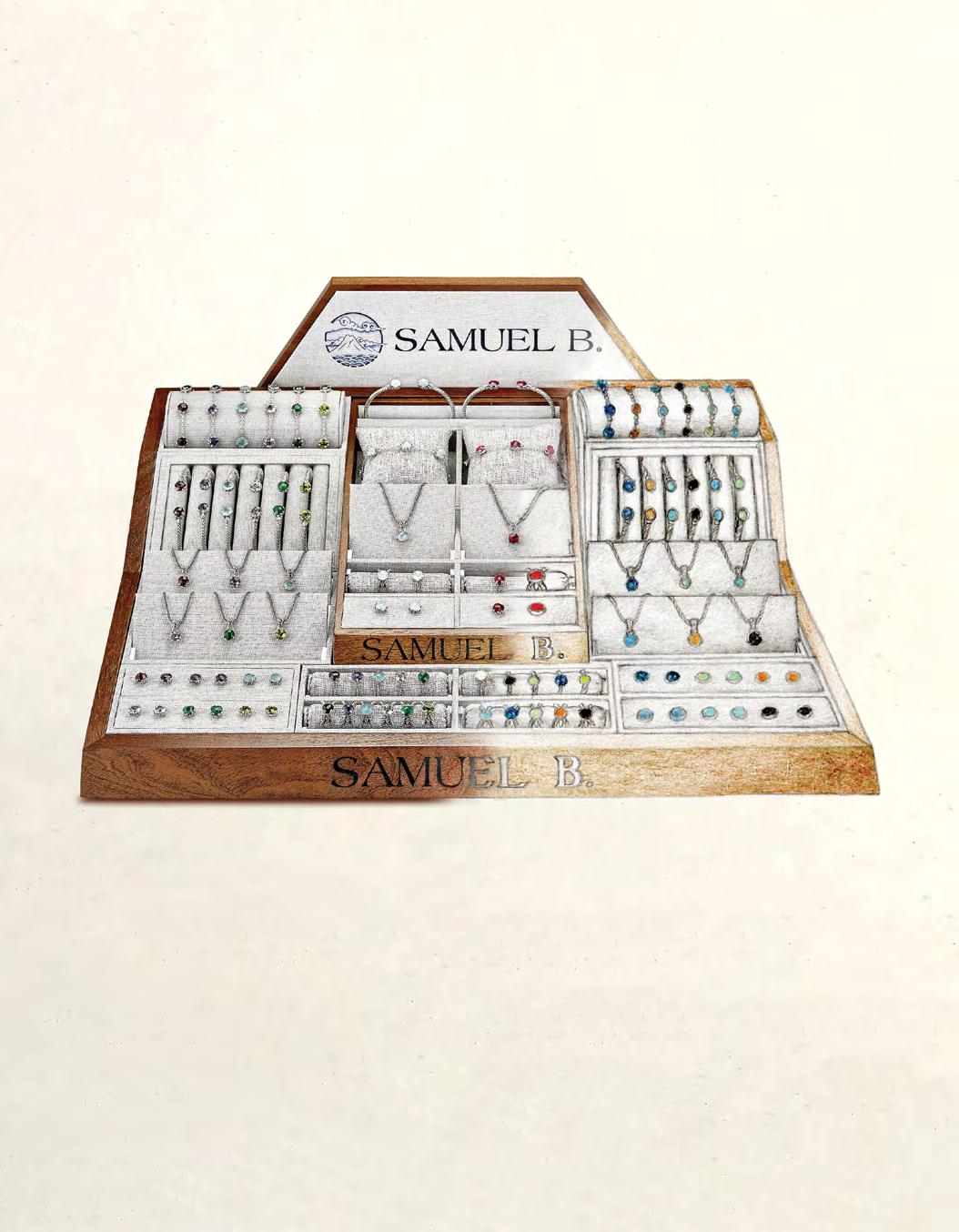

Planners, Designers, Manufacturers and Installers of Custom Jewelry Store Interiors.








LESLIE MCGWIRE

Your creativity and eye for detail are inspiring.












Your creativity and eye for detail are inspiring.
The Centurion columnist Leslie McGwire, Leslie McGwire & Associates Interior Design Company, has truly outdone herself with her wonderfully written collection of advice articles and curated, motivational store design photos that comprise our First Annual Jewelry Store Design Guide.

Inside you will find articles covering how to plan jewelry store layouts; how to choose the main color for your store’s interior; the ins and outs of the renovations and the use of “waiting areas,” among others.
There are also articles on the all-important special interior treatments like draperies, chandeliers and greenery. And a group of articles that zero in on show cases and more.
We know that you will want to keep and regularly refer back to the First Annual Jewelry Store Design Guide as you imagine the kind of customer experience you want to create and plan the ever-evolving design scheme that delivers on your store vision.
Here’s to your jewelry store and its amazing future!
Warmest regards,
Howard Hauben Editor In Chief & Publisher The CenturionCenturion
2019 Park Avenue, Merrick, NY 11566 516-377-5909 888-427-4697
info@centurionjewelry.com
centurionjewelry.com news.centurionjewelry.com


Meet Leslie McGwire, Leslie McGwire & Associates

Interior Design Company, West Bloomfield, MI
Leslie McGwire™ has over 35 years in business development, interior design and marketing services in retail and jewelry-based businesses. Leslie has won 25 national design awards, including the prestigious Salon Today and INSTORE Jewelry Store awards. Leslie has a true passion for business and design in the retail and jewelry industries. Visit LeslieMcgwire.com for more information.






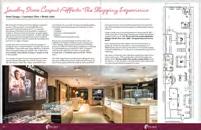
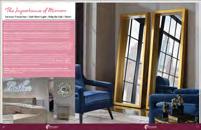



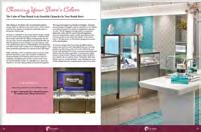
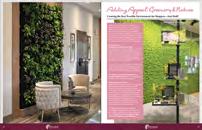
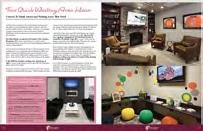

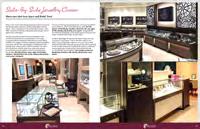



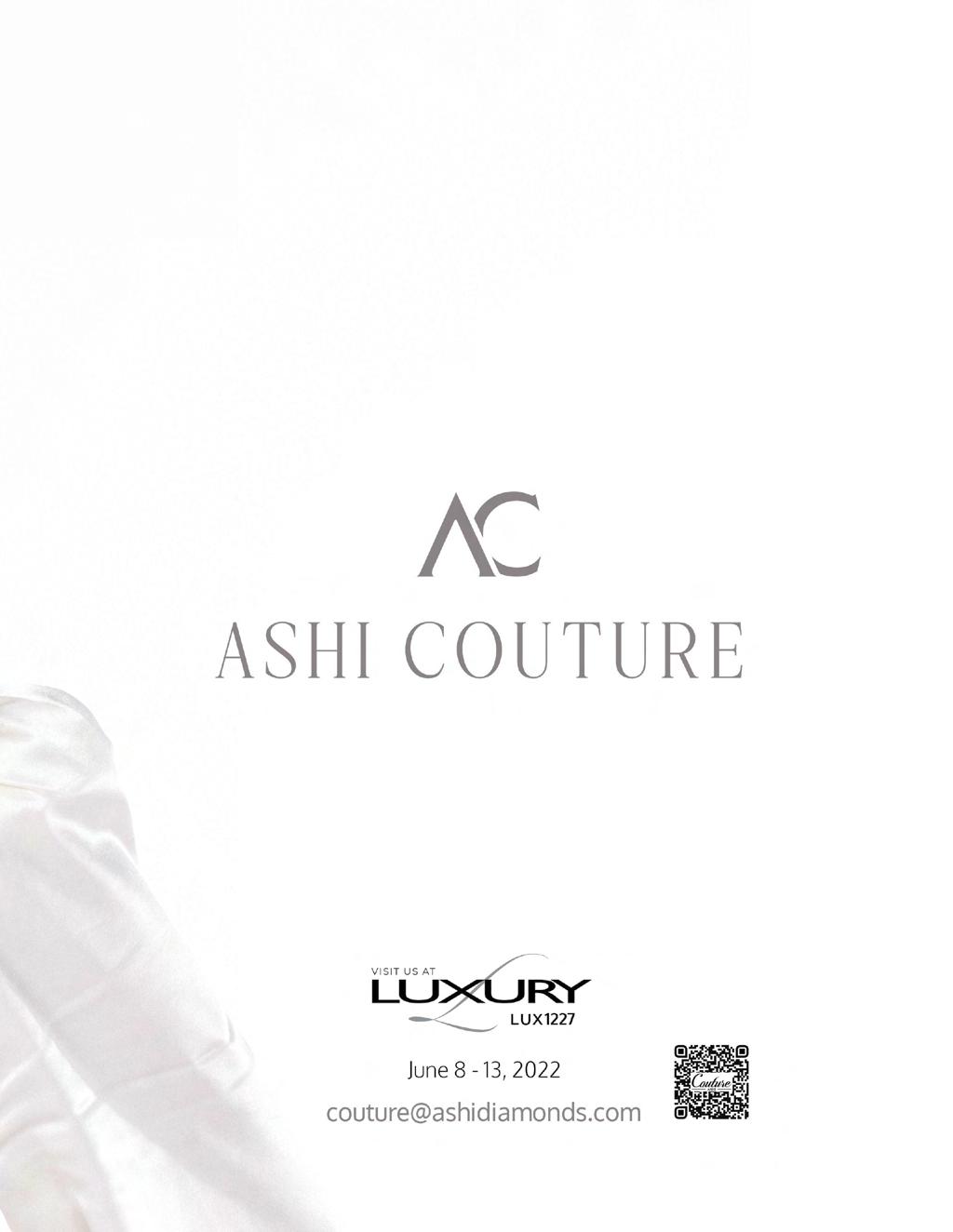


“What is the biggest step in a renovation?” jewelers ask. Create
Prior to the start of renovation, make sure you have created a comprehensive project budget and consider applying for a renovation/remodeling loan. No matter what the budget is, make sure to stick to it. An important part of sticking to the budget is to avoid making changes once the renovation process has begun. This can be achieved by outlining a clear and specific plan prior to renovating, which will ensure that all of your wants and needs are met. The more detailed the renovation plans are, the easier the process will be.
It’s important to keep in mind there may be expenses from moving existing infrastructure once the renovation begins (i.e. tearing down walls, raising ceilings, etc.). Plumbing, ductwork, and electric systems may need to be replaced, so plan on working around them in the retail space. An important tip is to plan all infrastructure changes ahead of time. Also stretch the remodeling budget by making necessary interior design improvements in the space.
The most important step in a renovation is to have a clear plan for the total process, including all logistics, whether you do a complete or a partial store remodel.
While renovating your store is a big expense, it is necessary to increase the overall revenue and return on investment (ROI).
The image at immediate right on this page is a preview of the final renovation. The larger image on the right hand page shows the before picture. Turn the page for an image of the stunning transformation.
Occasions Fine Jewelry & Gifts, Midland, TX, designed by Leslie McGwire & Associates Interior Design Company (LMA) from “Concept to Completion.”
Jewelry store owners should also find out which walls are load bearing, as changing layouts can sometimes affect these areas. Check your blueprint in PDF and AutoCAD forms with the design team (i.e. architect, jewelry store interior designer, general contractor, electrician, jewelry case manufacturer, and other finish vendors).

Make sure rules and expectations are set with your contractors and design team. Setting these expectations is a priority to make sure the renovation is successful.
For example, LMA recently enjoyed the interior design process with Occasions Fine Jewelry & Gifts owner Michael Fleck, see story images. This job finished the complete remodeling process with a total transformation of the retail space, which left the team highly satisfied. Open communication from LMA and the whole team increased proactive decision making to ensure all of Mr. Fleck’s wishes were completed beyond his expectations. He hired an excellent general contractor who made the entire remodel go very smoothly.

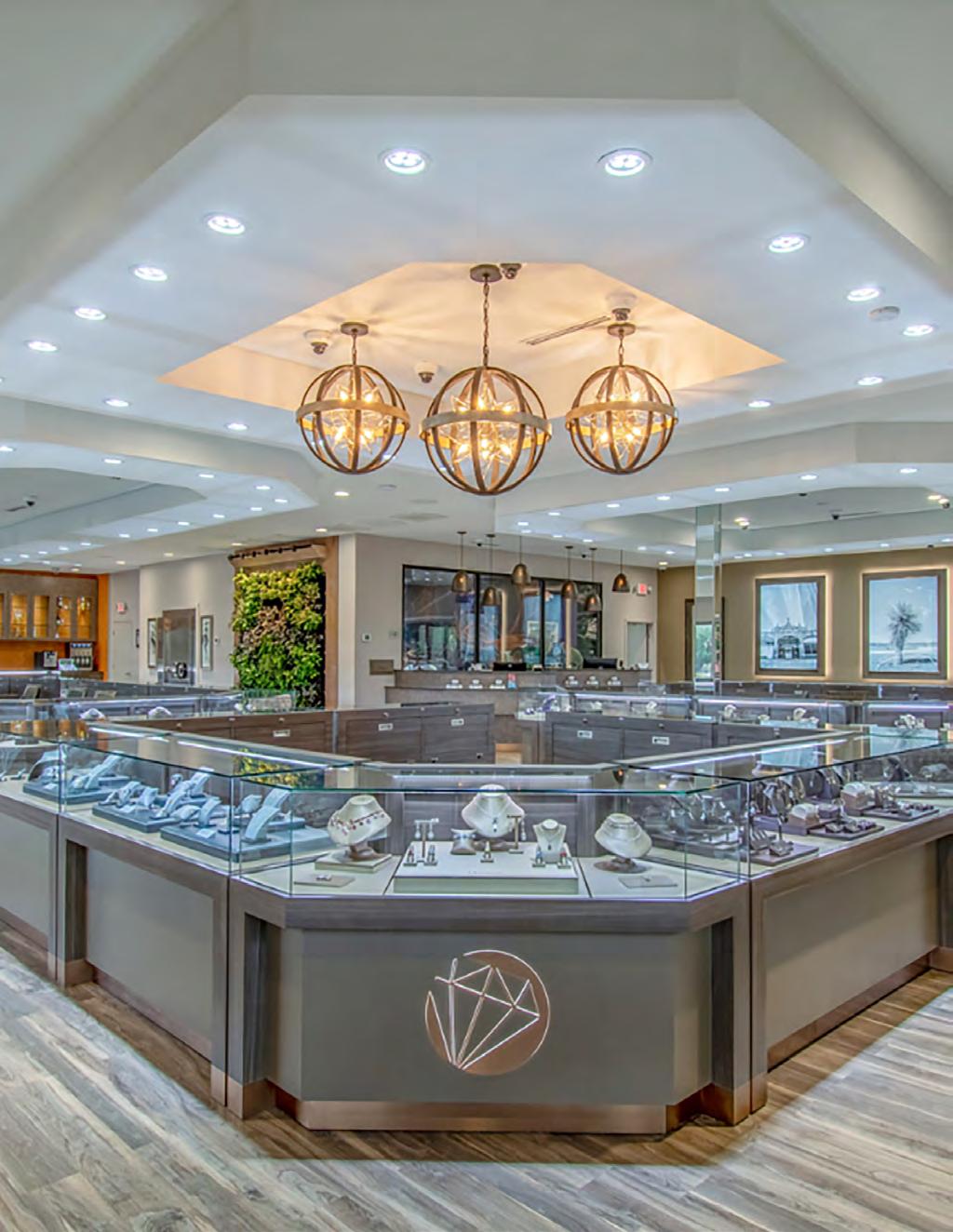

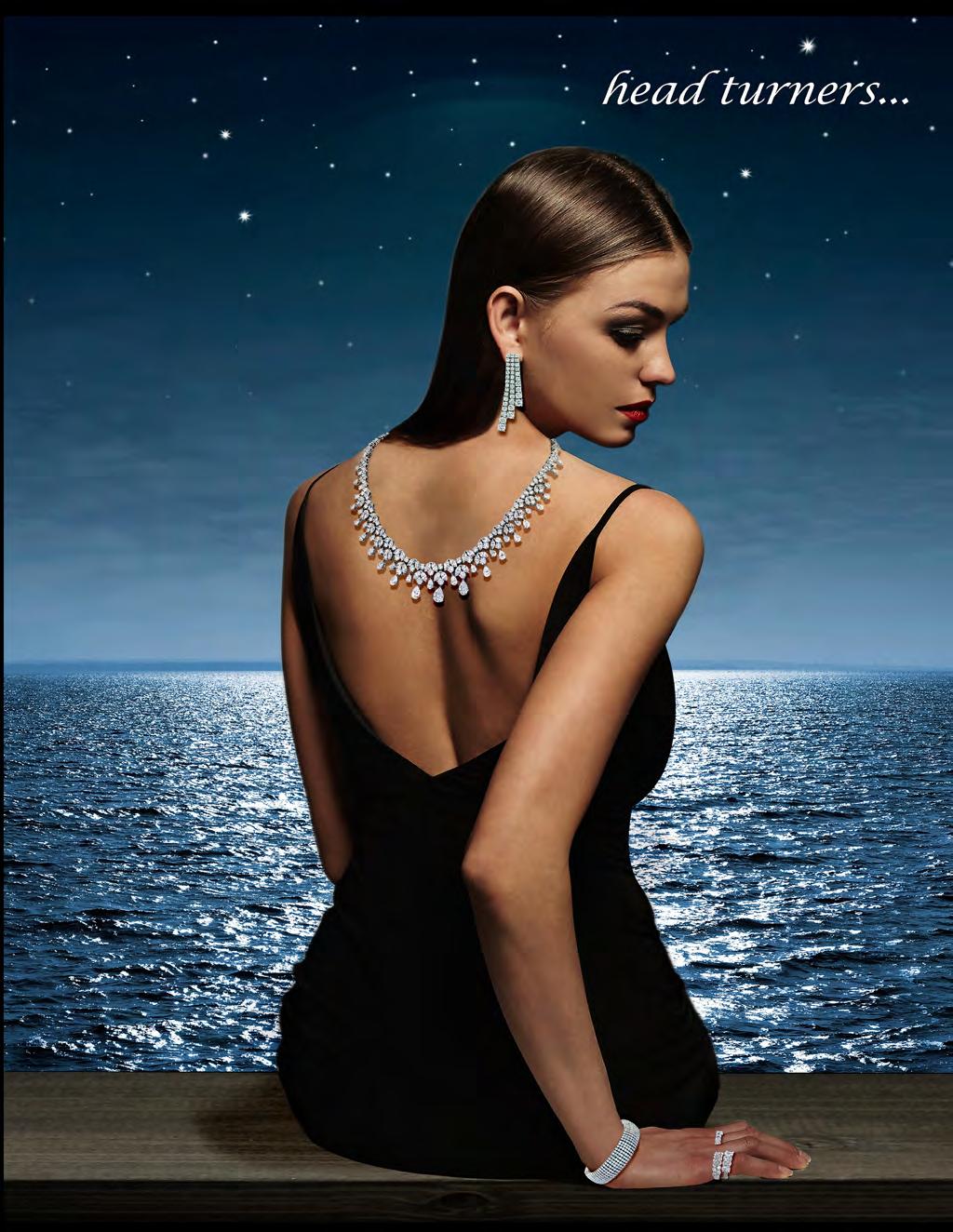
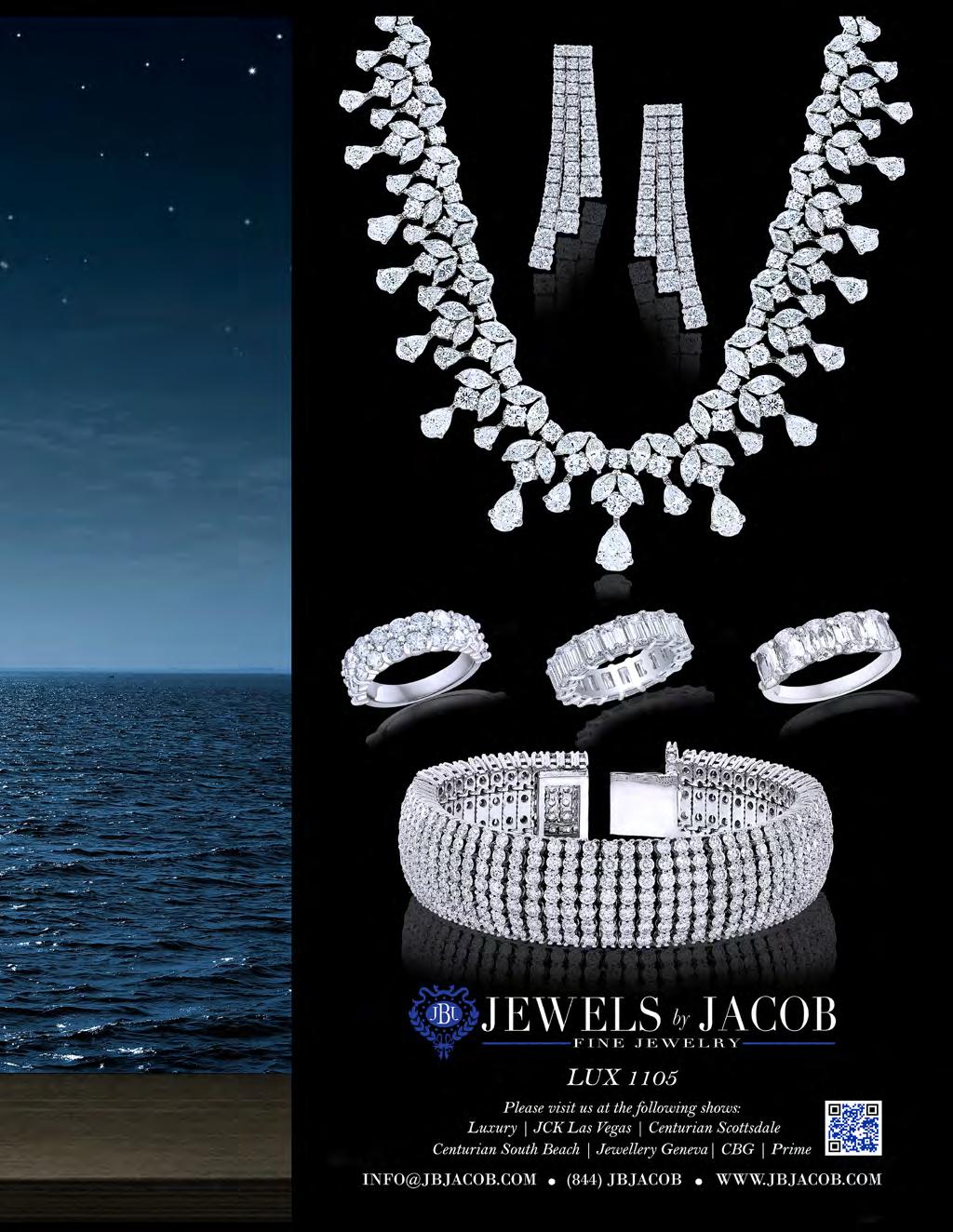



My clients ask me during the interior design consultation process, “How important is correct traffic flow and space planning for the jewelry store?” It is important for store owners to look at their stores from a customer’s viewpoint. With jewelry stores having to compete against big box jewelry stores and the Internet, it’s more important than ever to examine the jewelry store layout and create an EXPERIENCE that wows the customers and makes them want to return again and again.
Jewelry store case placement is extremely important in helping the store increase its bottom line sales. The overall presentation of the entire store layout affects the customer’s desire to purchase jewelry during their visit. It often takes a few essential interior design changes or updates to start increasing sales.
As an owner, the goal is to use every square foot of sales space to its best advantage. You want to choose a floor plan that fits your store’s size, shape, and matches your
merchandise. As you create the layout and display options, think about these ways that you could design your store:
• Straight
• Diagonal
• Geometric, including islands
• Angular
• Pullout/Side-Selling jewelry cases
Be sure to choose each design element in your store carefully. This includes choosing the color of cases, wall colors, flooring, lighting product and correct traffic flow placement. All these interior design perspectives contribute to a comfortable buying experience. When a customer enters into the store it’s nice to have a special table, museum case, or a different style case for the “WOW” factor.
The store image should have the interior design elements that cause customers to feel an emotional need to buy. As you all know, giving clients the ability to use more of their
fives senses to look, touch and feel the jewelry are all essential to close the emotional purchase through the updated interior design elements.
Create a bridal area, and special placement for your brands. With subtle zones, you will encourage customers to browse and discover everything you have to offer. See Lucido Fine Jewelry Rochester, Michigan for the floor plan, right, I designed (long and narrow store).


The Lucido family wanted to feature brands and price point in groupings. Review the floor plan so higher-priced jewelry is in different areas than the lesser–priced items such as fashion jewelry. Create the traffic flow so it is easy for the customers to shop and see everything.


Also, keep in mind that most customers naturally turn right as they enter a retail space. Think carefully about what merchandise you position there. See the Lucido Fine Jewelry picture below where the entrance on the right side is the Rolex brand and a waiting area with other brands located throughout the store.



Today more than ever, jewelry stores need to excel in visual jewelry merchandising. Using mirrors in the showroom can be an effective and low cost tool to create a visual experience for your customers. Mirrors not only enhance your interior design décor, but play a big role in overall experience for your customers. Here are a few reasons why mirrors are so important:
Lorem ipsum dolor sit amet, consectetur adipiscing elit, sed do eiusmod tempor incididunt ut labore et dolore magna aliqua. Ut enim ad minim veniam, quis nostrud exercitation ullamco laboris nisi ut aliquip ex ea commodo consequat. Duis aute irure dolor in reprehenderit in voluptate velit esse cillum dolore eu fugiat nulla pariatur.
Mirrors can visually increase the size of your jewelry store. If your store is really tight for space, you can easily install a wall-mounted mirror along the length of one of the walls and place a jewelry case below it to display your jewelry. This mirror dynamic still provides the same effect of spaciousness.
Excepteur sint occaecat cupidatat non proident, sunt in culpa qui officia deserunt mollit anim id est laborum.
Lorem ipsum dolor sit amet, consectetur adipiscing elit, sed do eiusmod tempor incididunt ut labore et dolore magna aliqua. Ut enim ad minim veniam, quis nostrud exercitation ullamco laboris nisi ut aliquip ex ea commodo consequat. Duis aute irure dolor in reprehenderit in voluptate velit esse cillum dolore eu fugiat nulla pariatur.
Excepteur sint occaecat cupidatat non proident, sunt in culpa qui officia deserunt mollit anim id est laborum.
Mirrors reflect light back into the space, providing more light in your store. Whether you use small, medium, large or a combination of mirrors in your store, this will bring in extra light and will create a pleasant experience for customers. See the Laskers Jewelers, Rochester, MN showroom below, which I designed with a small mirror over the beverage cart that also reflects on the jewelry cases.

Lorem ipsum dolor sit amet, consectetur adipiscing elit, sed do eiusmod tempor incididunt ut labore et dolore magna aliqua. Ut enim ad minim veniam, quis nostrud exercitation ullamco laboris nisi ut aliquip ex ea commodo consequat. Duis aute irure dolor in reprehenderit in voluptate velit esse cillum dolore eu fugiat nulla pariatur.
Lorem ipsum dolor sit amet, consectetur adipiscing elit, sed do eiusmod tempor incididunt ut labore et dolore magna aliqua. Ut enim ad minim veniam, quis nostrud exercitation ullamco laboris nisi ut aliquip ex ea commodo consequat. Duis aute irure dolor in reprehenderit in voluptate velit esse cillum dolore eu fugiat nulla pariatur.

Mirrors can help the sale. Place mirrors in strategic locations in your store to allow the customers to view how the jewelry looks on them. Customers who have chosen to come to the brick and mortar store (instead of shopping online) most likely to prefer to try on the jewelry before they make the purchase. Mirrors are key in these situations. See the concept picture right of two oversized gold-framed mirrors that are placed in the waiting area, giving clients space to walk up and see themselves with their jewelry on.
Excepteur sint occaecat cupidatat non proident, sunt in culpa qui officia deserunt mollit anim id est laborum.
Excepteur sint occaecat cupidatat non proident, sunt in culpa qui officia deserunt mollit anim id est laborum.
Adding a mirror to your space makes your store interactive. See the concept picture on the following page, where customers can walk up and see their entire body in the mirror, which is placed near the POS area.








When starting a design project, clients often ask about what designs to add to their walls. I suggest that commercial wallpaper significantly enhances the store image. In addition, commercial wallpaper is made differently than residential wallpaper.
Commercial wallpaper is made differently than residential wallpaper. Using it as wall covering gives a jewelry store an inexpensive way to create an accent wall and a unique feeling to the area.
Wall covering which is made of vinyl offers long-term benefits to the store. The important attributes include the following:

• Available in different patterns, colors, and textures to add warmth or cool tones to your store
• Durable and resistant

• Cost effective to maintain
• Compatible with cleaning agents intended to fight bacteria and other disease-causing micro-organisms
• Nonporous and highly cleanable
There is no hard-set rule that a commercial space chooses to use Type I or Type II commercial grade vinyl. Most commercial vinyl will be a faux linen, grass cloth or even textured design. This is fine for your store because these types of patterns tend to tie into the overall design of your store image.
Waterfall Jewelers and Williams Jewelers are two jewelry stores that have tapped into commercial wallpaper in their stores.
Williams Jewelers in Englewood, CO wanted a wall covering that gives a casual Denver feel, which was accomplished by using commercial wallpaper. See image below. See page 26 for the story of Waterfall Jewelers and their use of wallpaper.






When I designed Waterfall Jewelers in Waterford, MI, my client wanted a waiting area that was tied into being close to the metal vault and bar. The owners of Waterfall Jewelers chose the metalic, semi-shiny wall covering that matched the vault. See photo above.
They also wanted a trendy wall covering as an accent wall in their waiting area to coordinate with the other materials. See the right side of the picture of this area below.






After talking on the phone with my new jewelry interior design client, we started to discuss the color of their brand, and how they wanted to change the color after years of having their brand color.

This was so important to my overall interior design concept for their entire jewelry store look and feel. I told them that the teal blue used with the Tiffany Jewelry brand, red can of Coca-Cola, and the red/yellow arches of McDonalds are defining features of each company. In each instance, color is the predominant element of identification and association with their brand. Color enables us to instantly recognize and draw emotional associations to a brand of each retail store.
When choosing a color to represent your brand, you must think far beyond your personal, subjective preferences. Visual perception is the primary sense humans have for exploring and making sense of their environment. Once we humans identify a color, we instantly have a chemical reaction in our brain that produces an emotional response.
Many stores are known for their distinctive colors. At right, a striking blue from Waterfall Jewelers. On opposite page, Tiffany’s famous hue.

This response triggers a multitude of thoughts, memories and associations to people, places and events. Color affects us in profound ways. Our brains are designed to respond to color. This all happens instantly under our conscious awareness. Color sets the mood of brand expression, and more importantly, creates mental associations to the meaning of your brand within the context of the world it lives in. This fact ties in to the interior design environment of the overall space.
To convey a simple idea of meaning and differentiation requires you select a color that properly fits your strategic positioning. Selecting a color (and color scheme) for your brand must represent the clients emotional associations and desires, and the value proposition or promise your brand brings to those desires. Properly chosen colors will define your brand’s value in jewelry stores. Picking the right color should never be underestimated. Color branding and your interior design look can increase jewelry sales in your store.

















Jewelry retail is all about the customer experience. From the moment a customer walks through your store’s front door, he or she should be immersed in the shopping experience that encourages return visits and reflects your brand. A particularly interesting and effective approach that’s becoming more common is to use “green” design to create the best possible environment for shoppers.
The growing trend in retail design, including jewelry stores is sustainable living green walls. The “green” space may not be in the cards for every retail jewelry store. However, as a commercial interior designer, I like to bring nature inside if this approach fits with the owner's vision of their store.

The popular “green retail space” refers to the design trend of incorporating plants, living walls, and other greenery into the space, as well as natural features like wood and stone.
See picture at left of Occasions Fine Jewelry, Midland, Texas, where I designed the green wall for their retail space.
What explains the shift?


Different studies have shown that employees are happier, and more productive when they are surrounded by nature. Experts believe that “green” experiences can help customers feel more relaxed and enhance their mood while shopping for a variety of different jewelry. Therefore, when customers are shopping in a space that utilizes green elements, the positive emotions they experience will translate into more receptiveness and increased sales.
This happens because the customers associate visually appealing green spaces with higher quality and thus higher product value. See picture on this page of Oaks Jewelry & Boutique, Novi Michigan.


“What is the importance of a jewelry store waiting area?” My advice is that creating this space needs to make the customer feel relaxed, comfortable, and warm. By creating a proper waiting area, it allows customers and their significant others to experience a stress-free and enjoyable environment.
See the waiting area picture at The Diamond Center, Janesville, WI, below, where there is a built-in small refrigerator, with drinks and food displayed beautifully on top of the cabinet.
One of my favorite design elements I like to suggest in the waiting area is to incorporate electric fireplaces within the space. I design the fireplace walls as a focal point in the area. I make sure it reflects the design style of the overall store. Each stone or tile fits the overall design of the space.

In the Williams Jewelers waiting area, top image at right, I chose rough ledger stone to go with the Colorado design look of the store.
The other electronic element is to have a TV in the area for customers to watch while they wait. I tell my clients to have
1. Pay close attention to the traffic flow for optimizing its location.

2. Choose comfortable furniture along with upholstery and finishes that coordinate with the entire store.
3. Create a relaxing design décor in the waiting area. For example, set the mood of the area with lamps, chandeliers, and layered lighting.
4. Use technology and make sure there is WI-FI. Also, most of your customers will have devices with them to plug in while waiting.
5. Refreshments. Have a beautiful beverage cart, or a cabinet that could offer a selection of coffee, tea, fresh fruit, cold drinks, nutrition bars, small bags of packaged nuts, etc.

a loop of their advertising or specials they have going on for the month before the general education shows that are on the TV. Many times I place the TV above the fireplaces.
I also like to use area rugs in the waiting areas to convey a residential feel and a welcoming image. My favorite area rug that I designed for Crocker’s Fine Jewelry, Texarkana, TX, shown on Page 38, is a super thick and vey textural rug under the cocktail table. This gives the space a contemporary look like the store’s design.
If your store is large enough and your demographics are young families with children, it could be nice to add a children’s waiting or play area while their parents shop. It is important in the placement of that room that the children can see their parents and vice-versa. An example of children’s waiting area below at Crocker’s Fine Jewelry, bottom image at right.
As a business owner, you have the power to make your customer’s waiting experience stress-free and even enjoyable. Sit in your store’s waiting area and feel and see what your customers are experiencing. What would you do differently to make that area just right?







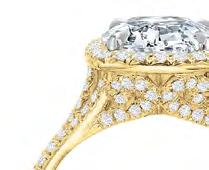

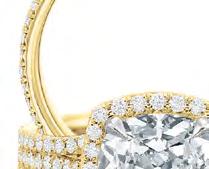
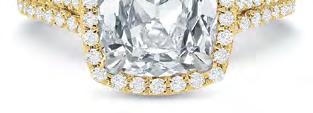
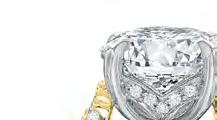
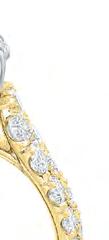
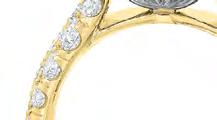
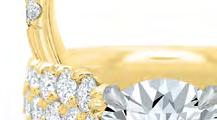
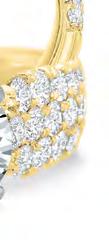
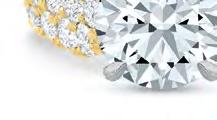

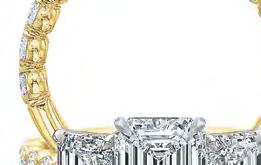
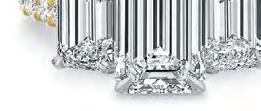




Many of my clients asked me how I chose the correct chandelier for their stores. If you are looking for the correct chandelier, my advice is to look with an open mind. As I have said many times, you need a WOW factor when clients enter your store. A chandelier can give customers wonderful and comfortable feelings as they enter.
Chandelier designs have a mix of styles and materials. It is important to know that you are in control of creating the store’s atmosphere by choosing the correct chandelier. I have told many clients for the past 35 years that the chandelier should look like an art piece. See Starburst Chandelier picture at right, from Lucido Fine Jewelry in Rochester, Michigan that I designed in the past year.
The chandelier needs to balance the scale and proportion of a room. It will promote the image of your unique individual brand. Chandeliers are ideal for every store, with coordinating additional lighting throughout different areas.
Here are a few more chandelier design tips:
• The minimum clearance should be at least seven feet above an individual’s head.

• Do not have a chandelier that is too small in scale. If anything, go bigger in size.
• There are no design rules in selecting the style of the chandeliers. You might hang a traditional crystal chandelier in a very modern space, or a contemporary chandelier in a traditional store. “No Rules.”
• A few popular styles used in jewelry stores are: Classic, Baroque, Modern, Minimalist, High Tech, Rustic and the Traditional style, below left, that I designed for Crocker’s Fine Jewelers in Texarkana, Texas.



Design trends like any other style trends are very important to your store’s image. In 2019, rustic chandeliers returned to fashion and interiors. They added modernity to the sophistication and ease to the store. In my design of Williams Jewelers in Englewood, Colorado, below right, the focus was to create an organic feel to the chandelier that has flowing glass gold leaves below the rustic wood ceiling.
Also design trends now are using multiple materials. The crystal chandeliers that are more contemporary in style are very hot in jewelry store designs. I designed the crystal chandeliers for Zorells Jewelers in Bismarck, North Dakota: see picture, Page 44. My design was to have individual crystal strands coming from the ceiling.











When I start new interior design projects many of my clients ask what jewelry cases give a selling advantage and save space. This is a big decision for jewelry store owners, and I often recommend side-by-side jewelry case design, since it gives many advantages.


Side-by-side jewelry cases allow the salesperson and customers to interact more comfortably and casually, compared with the traditional behind-the-counter selling method. The biggest difference between traditional jewelry cases and side-by-side case designs is selling behind the jewelry cases, which creates a barrier between the client and the jeweler. Side-by-side cases allow both parties to establish trust and agreement with a mutual goal to buy jewelry. See the picture, lower right, from Kelley Jewelers, Weatherford, OK, of the side-by-side jewelry case layout I designed.
The use of side-by-side jewelry cases can create trust within your customers, which can lead to more sales. See the picture of Buchkosky Jewelers, Roseville, WI, top right, of the side-by-side jewelry case layout I designed that provided the advantage of increased openness because the buyer and seller stand close to each other.
Another advantage to side-by-side cases is they can save you space in your store. I like to use both styles in the store. Using side-by-side cases can save your store three additional feet when they are up against the wall. According to the standard American Disability Act (ADA), a traditional jewelry space plan requires three feet behind the case so the staff can stand behind it. See another picture of Buchkosky Jewelers with side-by-side jewelry cases below.






Draperies can create an exquisite backdrop for interior walls and comprise a design element that greatly contributes to the final look and feel of a space. There are creative ways to use drapery to accomplish fresh design looks. When choosing to use drapery, it’s a good idea to consider the following benefits:

Creating a sense of ambiance is one of the most important reasons people consider drapery in jewelry stores. Adding draperies can transform your space and create a softer and more inviting feel. The interior I designed for Koerber’s Fine Jewelry in New Albany, IN, below, shows how drapery can be used along a wall to enhance the space. Light boxes were used to showcase their specific jewelry lines which appear to be floating on top of the material.
Another popular reason jewelers consider drapery is to bring a soft glow to the space and create a neutral backdrop for the room. The creative placement of drapery
adds softness to the store’s atmosphere. When looking for draperies, it’s important to choose luxurious commercial fabrics that add to your store’s overall image. Drapery adds a layer of luxury without distracting the jewelry store design.

When using draperies in your store, keep in mind that they can create a pop of color for your interior design. Draperies can resemble an accent design in your store. This is the perfect opportunity to use a unique pop of color or textural fabric if you want a statement piece in your store’s overall design. I designed the drink bar and waiting area at Crocker’s Fine Jewelry, right. This is a great example of a very tall accent and an appropriate color in this area. You can also be more subtle, and resemble a residential feel.
Adding unique drapery in your store is a more affordable option that can be modified frequently. Please use commercial fabrics for your draperies in your space.





